前交叉韧带胫骨止点撕脱性骨折演示文稿
- 格式:ppt
- 大小:2.85 MB
- 文档页数:19

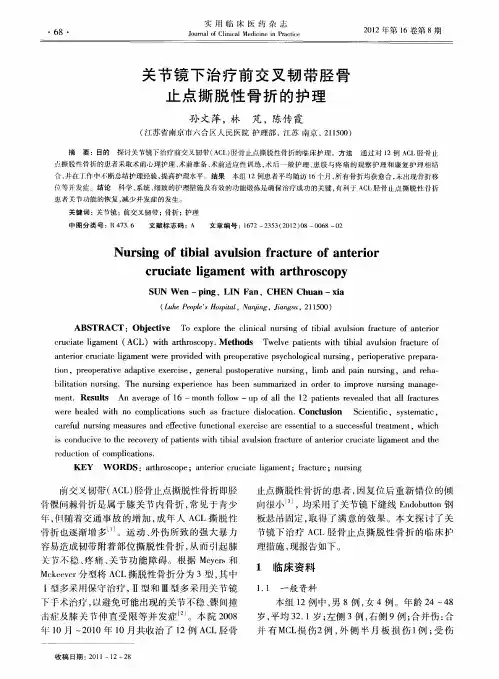
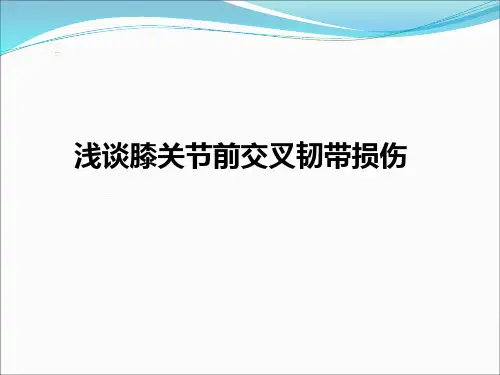
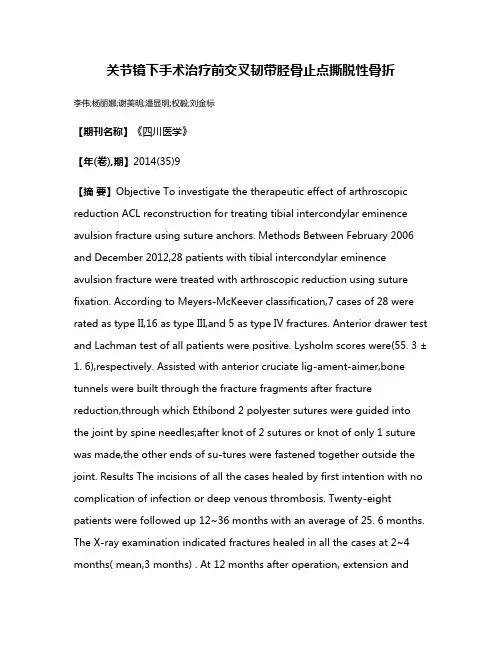
关节镜下手术治疗前交叉韧带胫骨止点撕脱性骨折李伟;杨丽娜;谢美明;潘显明;权毅;刘金标【期刊名称】《四川医学》【年(卷),期】2014(35)9【摘要】Objective To investigate the therapeutic effect of arthroscopic reduction ACL reconstruction for treating tibial intercondylar eminence avulsion fracture using suture anchors. Methods Between February 2006 and December 2012,28 patients with tibial intercondylar eminence avulsion fracture were treated with arthroscopic reduction using suture fixation. According to Meyers-McKeever classification,7 cases of 28 were rated as type II,16 as type III,and 5 as type IV fractures. Anterior drawer test and Lachman test of all patients were positive. Lysholm scores were(55. 3 ± 1. 6),respectively. Assisted with anterior cruciate lig-ament-aimer,bone tunnels were built through the fracture fragments after fracture reduction,through which Ethibond 2 polyester sutures were guided into the joint by spine needles;after knot of 2 sutures or knot of only 1 suture was made,the other ends of su-tures were fastened together outside the joint. Results The incisions of all the cases healed by first intention with no complication of infection or deep venous thrombosis. Twenty-eight patients were followed up 12~36 months with an average of 25. 6 months. The X-ray examination indicated fractures healed in all the cases at 2~4 months( mean,3 months) . At 12 months after operation, extension andflexion spheres of knee activity were normal in 26 cases and were limitedin 2 cases. The Lysholm score was(92. 5 ±2. 4),showing significant difference when compared with the preoperative score(t=42. 220,P=0. 000). Conclusion Suture fixation under arthroscope is an effective method with small invasion,reliable fixation,and simple operation for treating tibialinter-condylar anterior eminence fracture,and gave a simplicity,and effectiveness for anatomic ACL reconstruction.%目的:探讨关节镜下对前叉韧带胫骨止点撕脱骨折进行缝线栓结固定的手术方法及疗效分析。
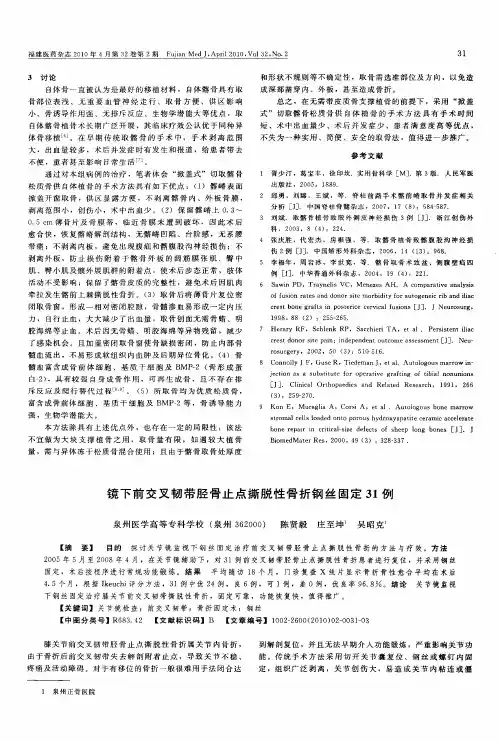
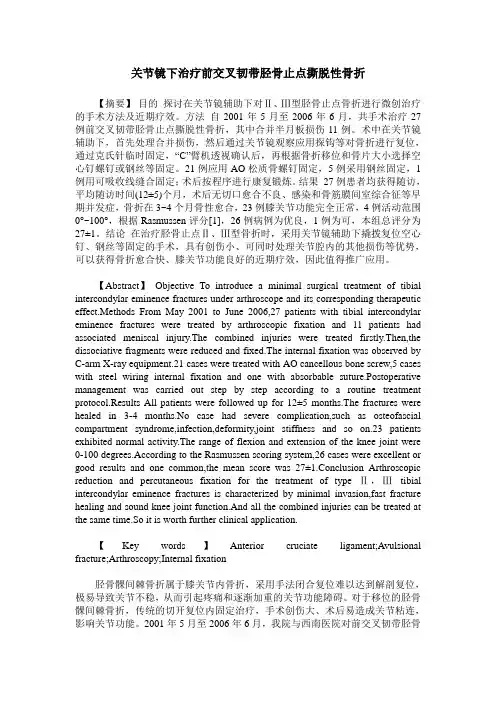
关节镜下治疗前交叉韧带胫骨止点撕脱性骨折【摘要】目的探讨在关节镜辅助下对Ⅱ、Ⅲ型胫骨止点骨折进行微创治疗的手术方法及近期疗效。
方法自2001年5月至2006年6月,共手术治疗27例前交叉韧带胫骨止点撕脱性骨折,其中合并半月板损伤11例。
术中在关节镜辅助下,首先处理合并损伤,然后通过关节镜观察应用探钩等对骨折进行复位,通过克氏针临时固定,“C”臂机透视确认后,再根据骨折移位和骨片大小选择空心钉螺钉或钢丝等固定。
21例应用AO松质骨螺钉固定,5例采用钢丝固定,1例用可吸收线缝合固定;术后按程序进行康复锻炼。
结果27例患者均获得随访,平均随访时间(12±5)个月,术后无切口愈合不良、感染和骨筋膜间室综合征等早期并发症,骨折在3~4个月骨性愈合,23例膝关节功能完全正常,4例活动范围0°~100°,根据Rasmussen评分[1],26例病例为优良,1例为可,本组总评分为27±1。
结论在治疗胫骨止点Ⅱ、Ⅲ型骨折时,采用关节镜辅助下撬拨复位空心钉、钢丝等固定的手术,具有创伤小、可同时处理关节腔内的其他损伤等优势,可以获得骨折愈合快、膝关节功能良好的近期疗效,因此值得推广应用。
【Abstract】Objective To introduce a minimal surgical treatment of tibial intercondylar eminence fractures under arthroscope and its corresponding therapeutic effect.Methods From May 2001 to June 2006,27 patients with tibial intercondylar eminence fractures were treated by arthroscopic fixation and 11 patients had associated meniscal injury.The combined injuries were treated firstly.Then,the dissociative fragments were reduced and fixed.The internal fixation was observed by C-arm X-ray equipment.21 cases were treated with AO cancellous bone screw,5 cases with steel wiring internal fixation and one with absorbable suture.Postoperative management was carried out step by step according to a routine treatment protocol.Results All patients were followed up for 12±5 months.The fractures were healed in 3-4 months.No case had severe complication,such as osteofascial compartment syndrome,infection,deformity,joint stiffness and so on.23 patients exhibited normal activity.The range of flexion and extension of the knee joint were 0-100 degrees.According to the Rasmussen scoring system,26 cases were excellent or good results and one common,the mean score was 27±1.Conclusion Arthroscopic reduction and percutaneous fixation for the treatment of type Ⅱ,Ⅲtibial intercondylar eminence fractures is characterized by minimal invasion,fast fracture healing and sound knee joint function.And all the combined injuries can be treated at the same time.So it is worth further clinical application.【Key words】Anterior cruciate ligament;Avulsional fracture;Arthroscopy;Internal fixation胫骨髁间棘骨折属于膝关节内骨折,采用手法闭合复位难以达到解剖复位,极易导致关节不稳,从而引起疼痛和逐渐加重的关节功能障碍。
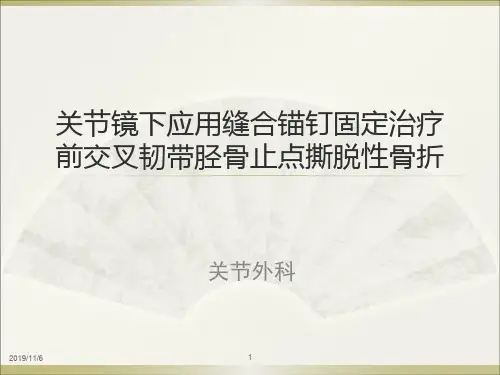

专题教程:前交叉韧带胫骨止点撕脱骨折的诊断与治疗作者简介刘忠国,主任医师、厦门市第三医院骨科主任。
厦门市骨科协和常委、福建省骨质疏松协会委员、中国中西医协会骨科微创专业委员会脊柱内镜学组委员、中国残疾康复学会脊柱微创学组委员。
擅长关节疾病的关节镜下微创治疗,膝关节及髋关节严重关节炎的全膝、单髋、全髋关节置换治疗,腰、颈椎间盘突出的微创间盘镜治疗,老年病人脊柱压缩骨折微创椎体成形术、复杂关节周围骨折手术治疗。
前交叉韧带胫骨止点撕脱骨折的诊断与治疗前交叉韧带止点撕脱骨折是前交叉韧带损伤的一种特殊类型,其发生率远远低于前交叉韧带实质部断裂,最常发生在儿童和青少年。
多见于摔伤,伤后患者常常出现膝关节肿胀、疼痛、不能负重、不能行走、不能正常屈伸膝关节。
解剖特点ACL附着于胫骨髁间棘前方稍偏内侧,卵圆形,面积约3㎝2;分前內束和后外束;外侧半月板前角是ACL胫骨止点一个附着区,常合并外侧半月板前角撕脱骨折,外侧半月板牵拉导致骨块向外侧移位,外侧半月板回缩变性导致骨块复位困难。
受伤机制前交叉韧带胫骨止点撕脱骨折主要由创伤引起,其受伤机制与前交叉韧带断裂相似,当膝关节处于过伸位时,受到一个外翻的应力,股骨外旋将导致前交叉韧带的实质部或者止点撕脱骨折。
在儿童和青少年患者中,引其骨骺发育不成熟,容易发生前交叉韧带胫骨止点撕脱骨折。
分型Meyers和McKeever于1959年首次将前交叉韧带胫骨止点撕脱骨折分为3型:骨折块无移位为Ⅰ型;骨折块前缘移位,后缘无移位的为Ⅱ型;骨折块完全移位为Ⅲ型。
Zaricznyj于1977年增加骨折块粉碎并完全移位为Ⅳ型。
ACL胫骨止点撕脱骨折的分型诊断有明确的外伤史:如运动损伤、摔伤、车祸等查体:膝关节肿胀、疼痛、行走困难;Lachman试验(),前抽屉试验(),部分患者出现伸膝受限;影像学检查:膝关节正侧位可明显看到胫骨平台前方髁间嵴骨折块分离,核磁共振显影可明确骨折块与前交叉韧带相连,为撕脱骨折块。
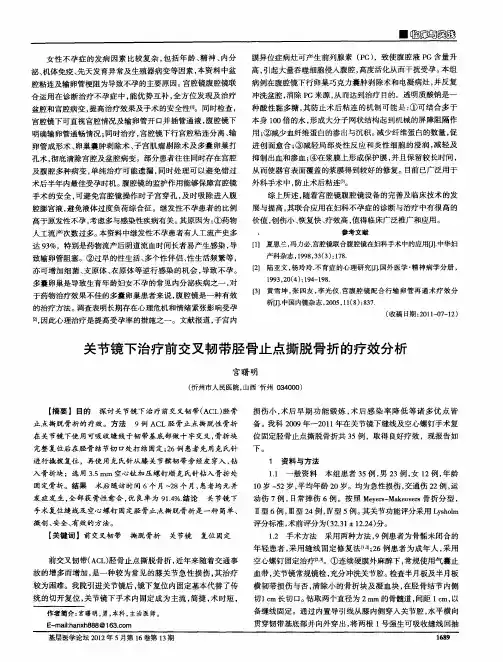

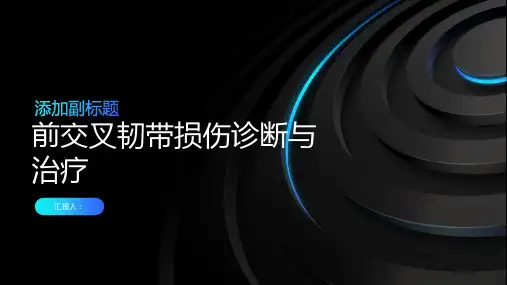
前交叉韧带胫骨止点撕脱骨折的关节镜下缝线固定
ACL胫骨止点撕脱骨折为关节内骨折,没有直接进行手法复位操作的措施,对于急性骨折,完全伸膝位髁间凹顶部对翘起的骨块的压迫有助于骨块复位。
但是急性骨折患者都有关节腔积血,在积血量大时完全伸膝会加剧疼痛(屈膝30°关节腔容量最大,痛感最轻)。
所以建议先穿刺抽吸关节积血,而后做数次伸直动作,最后用石膏固定于膝关节过伸位。
随后摄片检查,了解骨折复位情况。
如果骨折移位在5mm以内,继续行完全伸膝位固定即可;如果骨折移位超过5mm,建议行手术复位内固定,我们则建议在关节镜下进行复位固定。
一般来讲,有5mm移位的骨折即便能够愈合,也会造成5mm的关节松弛,加上韧带实质部损伤造成的韧带松弛,关节的松弛度可能会大于5mm。
需要强调的是,利用髁间凹顶部压迫复位最后造成的结构状态并不正常。
首先,在正常情况下,髁间凹顶部与ACL附着区并不接触,而利用髁间凹顶部压迫骨块最后造成的结果是两者接触。
尽管有可能达到膝关节过伸,但是一旦髁间凹或者ACL骨块部位有骨质增生,就会造成伸膝受限。
另外,利用髁间凹顶部压迫复位很少能达到解剖复位。
正常膝关节在伸膝极限时,髁间凹顶部与ACL附着部之间的空间就是骨折时骨块无法进一步下压的空间。
如果骨折在矢状面移位不明显,但是膝关节不能伸直,则需要手术治疗。
这一般是由骨折向外侧移位引起的。
如果骨折移位不明显,膝关节能过伸,但是膝关节过伸时有明显疼痛,也需要手术治疗,说明膝关节前室有撞击。
如果有合并损伤,如胫骨外侧平台后缘压缩骨折,半月板损伤等需要手术治疗,应附带进行ACL胫骨止点撕脱骨折的复位固定,以利于早起锻炼。